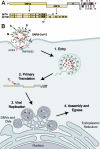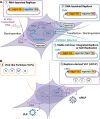Dimming the corona: studying SARS-coronavirus-2 at reduced biocontainment level using replicons and virus-like particles
- PMID: 39530689
- PMCID: PMC11633226
- DOI: 10.1128/mbio.03368-23
Dimming the corona: studying SARS-coronavirus-2 at reduced biocontainment level using replicons and virus-like particles
Abstract
The coronavirus-induced disease 19 (COVID-19) pandemic, caused by severe acute respiratory syndrome coronavirus-2 (SARS-CoV-2) infections, has had a devastating impact on millions of lives globally, with severe mortality rates and catastrophic social implications. Developing tools for effective vaccine strategies and platforms is essential for controlling and preventing the recurrence of such pandemics. Moreover, molecular virology tools that facilitate the study of viral pathogens, impact of viral mutations, and interactions with various host proteins are essential. Viral replicon- and virus-like particle (VLP)-based systems are excellent examples of such tools. This review outlines the importance, advantages, and disadvantages of both the replicon- and VLP-based systems that have been developed for SARS-CoV-2 and have helped the scientific community in dimming the intensity of the COVID-19 pandemic.
Keywords: COVID-19; SARS-CoV-2; coronavirus; drug discovery; replicon; vaccines; virus-like particles.
Conflict of interest statement
The authors declare no conflict of interest.
Figures


Similar articles
-
Advances in virus-like particle-based SARS-CoV-2 vaccines.Front Cell Infect Microbiol. 2024 Jun 26;14:1406091. doi: 10.3389/fcimb.2024.1406091. eCollection 2024. Front Cell Infect Microbiol. 2024. PMID: 38988812 Free PMC article. Review.
-
Construction and immunogenicity of SARS-CoV-2 virus-like particle expressed by recombinant baculovirus BacMam.Microbiol Spectr. 2024 Aug 6;12(8):e0095924. doi: 10.1128/spectrum.00959-24. Epub 2024 Jun 25. Microbiol Spectr. 2024. PMID: 38916311 Free PMC article.
-
A BSL-2 compliant mouse model of SARS-CoV-2 infection for efficient and convenient antiviral evaluation.J Virol. 2024 Jul 23;98(7):e0050424. doi: 10.1128/jvi.00504-24. Epub 2024 Jun 20. J Virol. 2024. PMID: 38899934 Free PMC article.
-
Development of a Single-Cycle Infectious SARS-CoV-2 Virus Replicon Particle System for Use in Biosafety Level 2 Laboratories.J Virol. 2022 Feb 9;96(3):e0183721. doi: 10.1128/JVI.01837-21. Epub 2021 Dec 1. J Virol. 2022. PMID: 34851142 Free PMC article.
-
Strengths and limitations of SARS-CoV-2 virus-like particle systems.Virology. 2025 Jan;601:110285. doi: 10.1016/j.virol.2024.110285. Epub 2024 Nov 5. Virology. 2025. PMID: 39536645 Review.
References
-
- Zhu N, Zhang D, Wang W, Li X, Yang B, Song J, Zhao X, Huang B, Shi W, Lu R, Niu P, Zhan F, Ma X, Wang D, Xu W, Wu G, Gao GF, Tan W, China Novel Coronavirus Investigating and Research Team . 2020. A novel coronavirus from patients with pneumonia in China, 2019. N Engl J Med 382:727–733. doi:10.1056/NEJMoa2001017 - DOI - PMC - PubMed
Publication types
MeSH terms
Substances
Grants and funding
- R01AI167356-02S1/HHS | NIH | National Institute of Allergy and Infectious Diseases (NIAID)
- T32AI106699/HHS | NIH | National Institute of Allergy and Infectious Diseases (NIAID)
- T32 AI106699/AI/NIAID NIH HHS/United States
- F31AI179424/HHS | NIH | National Institute of Allergy and Infectious Diseases (NIAID)
- F31 AI179424/AI/NIAID NIH HHS/United States
- R01AI167356/HHS | NIH | National Institute of Allergy and Infectious Diseases (NIAID)
- T32GM135060/HHS | NIH | National Institute of General Medical Sciences (NIGMS)
- F31AI174951/HHS | NIH | National Institute of Allergy and Infectious Diseases (NIAID)
- F31 AI174951/AI/NIAID NIH HHS/United States
- T32 GM135060/GM/NIGMS NIH HHS/United States
- R01 AI167356/AI/NIAID NIH HHS/United States
LinkOut - more resources
Full Text Sources
Medical
Miscellaneous

